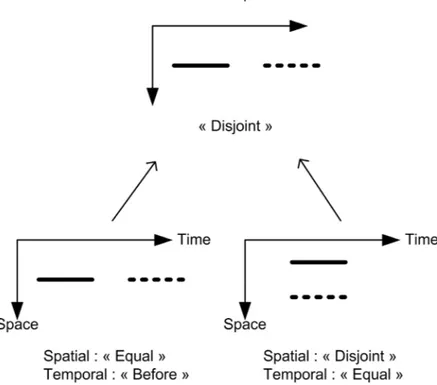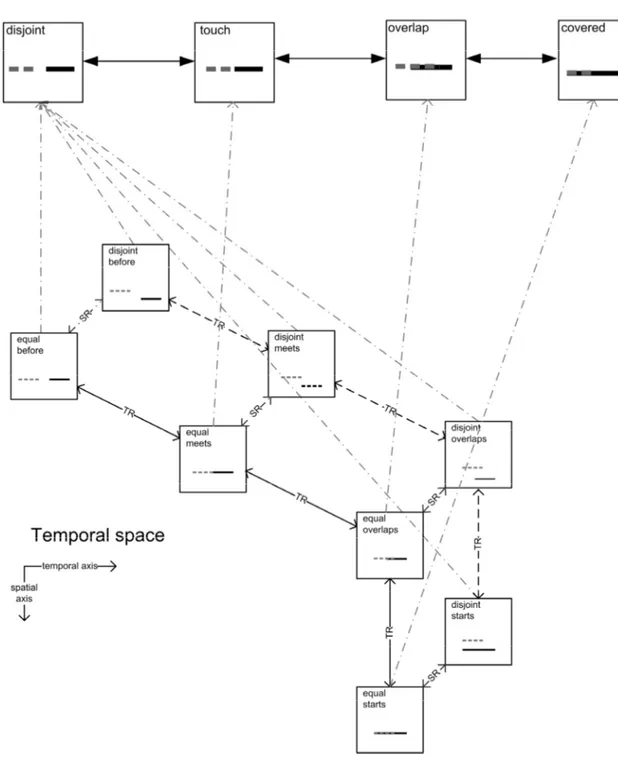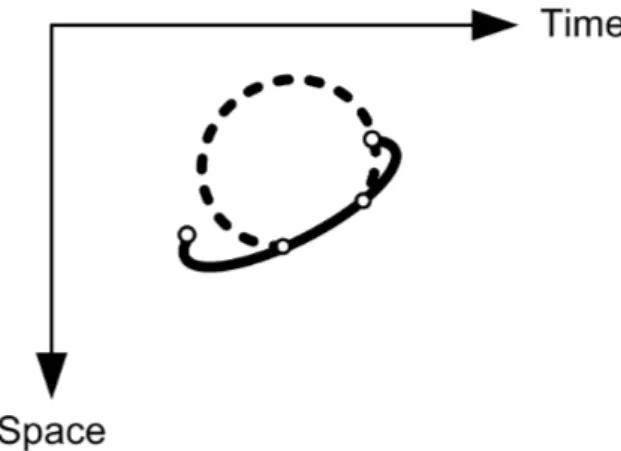Spatio-Temporal Relationships in a Primitive Space:
an attempt to simplify spatio-temporal analysis
Pierre Hallot1
1Geomatics Unit / University of Liège (Belgium)
P.Hallot@ulg.ac.be INTRODUCTION
Nowadays, huge amount of dynamic spatial data is available notably due to the improvement of data acquisition techniques (e.g. on-board GPS). This provides basic information allowing performing complex spatio-temporal analyses such as, movement description, region evolution, trajectory calcu-lus,… However, considering time in spatial analyses increases rapidly their complexity (Renz and Nebel, 1999). We are still far from standard spatio-temporal functionality. An answer to this assessment can be a generalisa-tion of spatio-temporal relageneralisa-tionships. Considering a higher level of rela-tionships abstraction should reduce spatio-temporal analysis complexity. However, such generalised model should preserve enough spatio-temporal signification.
In our research, we aim to explore such generalised spatio-temporal rela-tionships. Our first research objective is to go back to the foundation of spatio-temporal relationships between objects. In this paper, we present a model based on a primitive spatio-temporal space, i.e. where spatial and time dimension are not differentiate (Muller, 1998).
This field of research has been explored for quite a while. We wish to men-tion three researches which have especially inspired our work; a descripmen-tion of spatio-temporal lines made by points moving at constant speed in a rela-tional model (Balbiani and Farinas, 1996), a description of spatial relation-ships between regions in an integrated referential called temporal spaces (Claramunt and Jiang 2000, 2001), and more recently a formal model de-scribing movement of points over time (i.e. with direction, speed, accelera-tion), the qualitative trajectory calculus (Van de Weghe et al., 2006). We have adopted a two steps approach. First, we combine temporal (inter-val) relationships and spatial (topological) relationships between objects. In other words, we establish all the spatio-temporal configurations for two ob-jects in a temporal space (Claramunt and Jiang, 2000). To do so, we use topological relationships (Egenhofer and Al-Taha, 1992) and Allen’s time intervals (Allen, 1984). These spatio-temporal configurations are organised
as a conceptual neighbourhood diagram (Freska, 1991). In the second step, we study the relevance of their generalisation in a primitive space (Muller, 1998).
The rest of the paper is organised as follow; first, we describe temporal relationships in temporal spaces. Then, we generalize spatio-temporal relationships in primitive spaces, finally we present future devel-opment and we conclude.
RELATIONSHIPS IN A TEMPORAL SPACE
The possible spatio-temporal configurations are presented following the structure of temporal spaces (Claramunt and Jiang, 2000, 2001) with an axis for each dimension as shown in figure 1.
Fig. 1: Two static points in a temporal space (spatial relation “equal”, temporal relations “before” (A) and spatial relation “disjoint”, temporal relation “equal” (B)).
Our research begins with the establishment of spatio-temporal configura-tion by using 1D space with two static points. In this particular case, only two spatial topological relationships are possible; “equal” or “disjoint”. This property reduces the number of spatio-temporal configurations. How-ever, the thirteen temporal relations are still valid. Figure 2 presents an ex-tract of the possible configurations.
Fig. 2: 8 cases out of the 26 possible spatio-temporal relationships of two static points in a 1D space.
For two static points in a one dimensional space, we found 26 possible spa-tio-temporal configurations and theoretically we have 429 possibilities when considering two moving points. The number of possible cases and the diagram’s size increase rapidly with dimension over 1.
RELATIONSHIPS IN A PRIMITIVE SPACE
As we can see, working in temporal spaces may become (too) complex when considering other spatial dimensions (2 and 3) and other types of moving objects (e.g. regions). This is the reason why we wish to investigate
primitive spaces as a framework for spatio-temporal representation (Muller, 1998). In these spaces they are no difference between spatial and temporal dimension. Therefore, we can use topological relationships applied to spa-tio-temporal objects (created by moving spatial objects over time) as a model for spatio-temporal relationships. Such a representation is indeed a cluster of previous temporal spaces representation. Thus, we reduce the number of the possible spatio-temporal configuration to a small set of well-known topological relationships. The two examples shown in figure 1 can be summarized as “disjoint” (see figure 3.)
Fig. 3: Representation in a primitive space of spatio-temporal relation-ships.
The model for two static points has been done. In this case, we move from 26 spatio-temporal relationships to 8 topological relationships in a primi-tive space. Figure 4 presents part of the model.
Fig. 4: Clusters of spatio-temporal relationships in a primitive space. One of our research objectives tries to determine if such a clustering con-tain sufficient information to perform spatio-temporal analyses. For exam-ple, in the 2 static point model, the topological “disjoint” relationships in primitive space represents all the cases where the two points are not in the same place at the same moment. This could be useful to perform collision
detection. Another interest of this method is the speed up extraction of spa-tio-temporal configuration about moving objects. It could be of great inter-est when dealing with huge quantity of dynamic spatial data.
FUTURE DEVELOPMENTS
The model has been extended to 2 moving points in a 1D space. In this case, we use the topological relationships between lines (Egenhofer and Herring, 1990). However we can exclude some cases of topological relation that are impossible if we consider that no returns in the past are possible (see figure 5). Research is still in progress to describe all possibility of two moving points and about identification of what is the elementary movement of points. We envisage to extend the model to more complex situations (e.g. moving regions in a 2D space).
Fig. 5: Example of an impossible spatio-temporal relationship between two moving points corresponding to a possible topological rela-tionship between lines.
CONCLUSION
This work is based on the combination of spatial and temporal relationships to describe spatio-temporal relationships. Two spaces are considered; tem-poral spaces and primitive spaces. The research aims to express spatio-temporal relationships in a primitive space. Thus, we developed a general-ised model of spatio-temporal relationships using “simple” topological re-lationships (in our case, topological rere-lationships in a 2D space). It seems to contain enough spatio-temporal information to perform spatio-temporal analyses. We believe that it could reduce analysis complexity and therefore
could represent a major improvement in this field. The next step of our re-search is going to be the validation of these statements.
REFERENCES
Allen, J.F. (1984). "A General Model of Action and Time.'' Artificial Intel-ligence 23(2).
Balbiani, P. and F. del Cerro (1996). "A relational model of movement.” Logique et Analyse 155-156: 369-378.
Claramunt, C. and B. Jiang (2000). "A Representation of Relationships in Temporal Spaces." Innovation in GIS VII: Geocomputation. Martin D. and P. Atkinson (eds.). London, Taylor & Francis, (4): 41-53.
Claramunt, C. and B. Jiang (2001). "A Integrated Representation of Spatial and Temporal Relationships between Evolving Regions." Geographical Systems 3: 411-428.
Egenhofer, M. J. and J. Herring (1990). "Categorizing Binary Topological Relations Between Regions, Lines, and Points in Geographic Databases." Technical Report, Department of Surveying Engineering, University of Maine.
Egenhofer M. and K. Al-Taha (1992). "Reasoning about binary topological relations. In Advances in spatial databases, Günther O. and H.J. Schek (eds.) Berlin Springer: 196-219.
Freska C. (1991). "Conceptual neighbourhood and it’s role un temopal and spatial reasoning." In Decision Support Systems and Qualitative Reason-ing, Singh M. and L. Travé-Massuyès (eds.) Amsterdam: 181-187.
Muller, P. (1998). "Topological Spatio-Temporal Reasoning and Represen-tation." Computational Intelligence 18(3): 420-450.
Renz, J. and B. Nebel (1999). “On the Complexity of Qualitative Spatial Reasoning: A Maximal Tractable Fragment of the Region Connection Calculus.” Artificial Intelligence 1-2: 95-149.
Van de Weghe, N., A. G. Cohn, G. De Tre and P. De Maeyer (2006). "A Qualitative Trajectory Calculus as a Basis for Representing Moving Ob-jects in Geographical Information Systems." Control and Cybernetics 35(1). 20.



